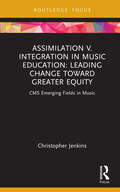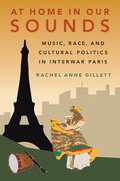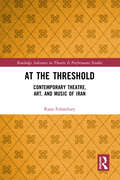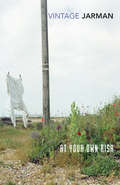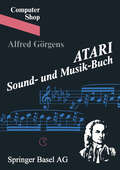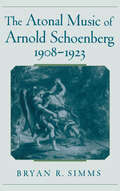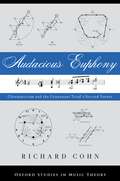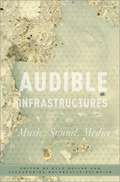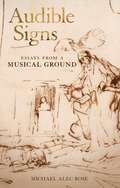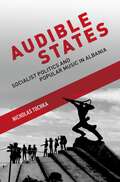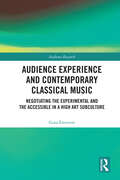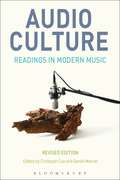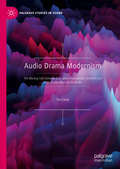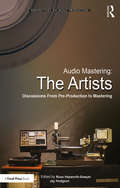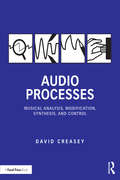- Table View
- List View
Assimilation v. Integration in Music Education: Leading Change toward Greater Equity (CMS Emerging Fields in Music)
by Christopher JenkinsAssimilation v. Integration in Music Education engages with an existential question for American conservatories and orchestras: What does it mean to diversify Western classical music? Many institutions have focused solely on diversifying the demography of their participants, but without a deeper conversation about structural oppression in classical music, this approach continues to isolate and exclude students of color. Rooted in the author’s experience working with BIPOC (Black, Indigenous, and People of Color) students at a major American conservatory, this book articulates the issues facing minority students in conservatories and schools of music, going beyond recruitment to address the cultural issues that alienate students. The author argues that the issue of diversity should be approached through the lens of aesthetics, and that the performance and pedagogy of Western classical music must change if a more diverse membership is to thrive in this genre. Reflecting on the author’s experience through the lens of recent critical theory in music education, this volume presents the viewpoints of Black and Latinx music students in their own words. Addressing the impact of racialized aesthetics on the well-being of BIPOC music students, the author shows how students are alienated when attempting to assimilate into conservatory environments and envisions an alternative, integrative approach to conservatory education. Offering a deep dive into the psychological and cultural reasons for the racialization of Western classical music, and potential institutional solutions, this concise book is relevant to performers, students, and institutional leaders.
Assimilation v. Integration in Music Education: Leading Change toward Greater Equity (CMS Emerging Fields in Music)
by Christopher JenkinsAssimilation v. Integration in Music Education engages with an existential question for American conservatories and orchestras: What does it mean to diversify Western classical music? Many institutions have focused solely on diversifying the demography of their participants, but without a deeper conversation about structural oppression in classical music, this approach continues to isolate and exclude students of color. Rooted in the author’s experience working with BIPOC (Black, Indigenous, and People of Color) students at a major American conservatory, this book articulates the issues facing minority students in conservatories and schools of music, going beyond recruitment to address the cultural issues that alienate students. The author argues that the issue of diversity should be approached through the lens of aesthetics, and that the performance and pedagogy of Western classical music must change if a more diverse membership is to thrive in this genre. Reflecting on the author’s experience through the lens of recent critical theory in music education, this volume presents the viewpoints of Black and Latinx music students in their own words. Addressing the impact of racialized aesthetics on the well-being of BIPOC music students, the author shows how students are alienated when attempting to assimilate into conservatory environments and envisions an alternative, integrative approach to conservatory education. Offering a deep dive into the psychological and cultural reasons for the racialization of Western classical music, and potential institutional solutions, this concise book is relevant to performers, students, and institutional leaders.
At Home in Our Sounds: Music, Race, and Cultural Politics in Interwar Paris
by Rachel Anne GillettAt Home in Our Sounds illustrates the effect jazz music had on the enormous social challenges Europe faced in the aftermath of World War I. Examining the ways African American, French Antillean, and French West African artists reacted to the heightened visibility of racial difference in Paris during this era, author Rachel Anne Gillett addresses fundamental cultural questions that continue to resonate today: Could one be both black and French? Was black solidarity more important than national and colonial identity? How could French culture include the experiences and contributions of Africans and Antilleans? Providing a well-rounded view of black reactions to jazz in interwar Paris, At Home in Our Sounds deals with artists from highly educated women like the Nardal sisters of Martinique, to the working black musicians performing at all hours throughout the city. In so doing, the book places this phenomenon in its historical and political context and shows how music and music-making constituted a vital terrain of cultural politics--one that brought people together around pianos and on the dancefloor, but that did not erase the political, regional, and national differences between them.
At Home in Our Sounds: Music, Race, and Cultural Politics in Interwar Paris
by Rachel Anne GillettAt Home in Our Sounds illustrates the effect jazz music had on the enormous social challenges Europe faced in the aftermath of World War I. Examining the ways African American, French Antillean, and French West African artists reacted to the heightened visibility of racial difference in Paris during this era, author Rachel Anne Gillett addresses fundamental cultural questions that continue to resonate today: Could one be both black and French? Was black solidarity more important than national and colonial identity? How could French culture include the experiences and contributions of Africans and Antilleans? Providing a well-rounded view of black reactions to jazz in interwar Paris, At Home in Our Sounds deals with artists from highly educated women like the Nardal sisters of Martinique, to the working black musicians performing at all hours throughout the city. In so doing, the book places this phenomenon in its historical and political context and shows how music and music-making constituted a vital terrain of cultural politics--one that brought people together around pianos and on the dancefloor, but that did not erase the political, regional, and national differences between them.
At the Threshold: Contemporary Theatre, Art, and Music of Iran (Routledge Advances in Theatre & Performance Studies)
by Rana EsfandiaryThis book examines the performance strategies used by contemporary Iranian artists and activists to reimagine “Iranian-ness” in the context of Iran’s local, regional, and global position. This study identifies the important social and political interventions made by theatrical and performance pieces, visual art, and electronic music that articulate and reformulate Iranian-ness by breaking away from fixed and constructed stereotypes projected on them by both the Islamic regime and Western power. This book explores the reception and context within which artworks become meaningful performative acts. Looking closely at the works of a notable female Iranian photographer, Shadi Ghadirian, in conjunction with the new generation of Iranian nonconformist artists/activists such as Tahmineh Monzavi and Hedieh Ahmadi; the visionary theatre productions of Ali Akbar Alizad; and radically untraditional sound/noise of the electronic music movement in Tehran, this book calls attention to the Iran-based artists who are tirelessly trying to raise awareness regarding the political violence imposed on Iranian identity at the legal (top-down) and everyday (bottom-up) levels. This volume will be of great interest to student and scholars in theatre and performance, photography, art, music, sociology, and politics.
At the Threshold: Contemporary Theatre, Art, and Music of Iran (Routledge Advances in Theatre & Performance Studies)
by Rana EsfandiaryThis book examines the performance strategies used by contemporary Iranian artists and activists to reimagine “Iranian-ness” in the context of Iran’s local, regional, and global position. This study identifies the important social and political interventions made by theatrical and performance pieces, visual art, and electronic music that articulate and reformulate Iranian-ness by breaking away from fixed and constructed stereotypes projected on them by both the Islamic regime and Western power. This book explores the reception and context within which artworks become meaningful performative acts. Looking closely at the works of a notable female Iranian photographer, Shadi Ghadirian, in conjunction with the new generation of Iranian nonconformist artists/activists such as Tahmineh Monzavi and Hedieh Ahmadi; the visionary theatre productions of Ali Akbar Alizad; and radically untraditional sound/noise of the electronic music movement in Tehran, this book calls attention to the Iran-based artists who are tirelessly trying to raise awareness regarding the political violence imposed on Iranian identity at the legal (top-down) and everyday (bottom-up) levels. This volume will be of great interest to student and scholars in theatre and performance, photography, art, music, sociology, and politics.
At Your Own Risk: A Saint's Testament
by Derek JarmanSpanning his entire life and divided into decades from the forties to the nineties, this book brings together Jarman's poetry, prose, memoirs, photographs and film transcripts and includes newspaper extracts on aspects of gay culture. The result is a rounded portrait of homosexuality through the twentieth century seen through a fiercely personal perspective.At Your Own Risk is angry, entertaining and humane, both a powerful argument against homophobia and a wild celebration of an individual's sexuality and freedom.
The Atonal Music Of Arnold Schoenberg, 1908-1923
by Bryan R. SimmsBetween 1908 and 1923, Arnold Schoenberg began writing music that went against many of the accepted concepts and practices of this art. Largely following his intuition during these years, he composed some of the masterpieces of the modern repertoire--includingPierrot lunaireandErwartung--works that have since provoked a large, though fragmented, body of critical and analytical writing. In this book, Bryan Simms combines a historical study with a close analytical reading of the music to give us a new and richer understanding of Schoenberg's seminal work during this period.
The Atonal Music of Arnold Schoenberg, 1908-1923
by Bryan R. SimmsBetween 1908 and 1923, Arnold Schoenberg began writing music that went against many of the accepted concepts and practices of this art. Largely following his intuition during these years, he composed some of the masterpieces of the modern repertoire--including Pierrot lunaire and Erwartung--works that have since provoked a large, though fragmented, body of critical and analytical writing. In this book, Bryan Simms combines a historical study with a close analytical reading of the music to give us a new and richer understanding of Schoenberg's seminal work during this period.
Audacious Euphony: Chromatic Harmony and the Triad's Second Nature (Oxford Studies in Music Theory)
by Richard CohnMusic theorists have long believed that 19th-century triadic progressions idiomatically extend the diatonic syntax of 18th-century classical tonality, and have accordingly unified the two repertories under a single mode of representation. Post-structuralist musicologists have challenged this belief, advancing the view that many romantic triadic progressions exceed the reach of classical syntax and are mobilized as the result of a transgressive, anti-syntactic impulse. In Audacious Euphony, author Richard Cohn takes both of these views to task, arguing that romantic harmony operates under syntactic principles distinct from those that underlie classical tonality, but no less susceptible to systematic definition. Charting this alternative triadic syntax, Cohn reconceives what consonant triads are, and how they relate to one another. In doing so, he shows that major and minor triads have two distinct natures: one based on their acoustic properties, and the other on their ability to voice-lead smoothly to each other in the chromatic universe. Whereas their acoustic nature underlies the diatonic tonality of the classical tradition, their voice-leading properties are optimized by the pan-triadic progressions characteristic of the 19th century. Audacious Euphony develops a set of inter-related maps that organize intuitions about triadic proximity as seen through the lens of voice-leading proximity, using various geometries related to the 19th-century Tonnetz. This model leads to cogent analyses both of particular compositions and of historical trends across the long nineteenth century. Essential reading for music theorists, Audacious Euphony is also a valuable resource for music historians, performers and composers.
Audible Infrastructures (Critical Conjunctures in Music and Sound)
by Kyle Devine and Alexandrine Boudreault-FournierOur day-to-day musical enjoyment seems so simple, so easy, so automatic. Songs instantly emanate from our computers and phones, at any time of day. The tools for playing and making music, such as records and guitars, wait for us in stores, ready for purchase and use. And when we no longer need them, we can leave them at the curb, where they disappear effortlessly and without a trace. These casual engagements often conceal the complex infrastructures that make our musical cultures possible. Audible Infrastructures takes readers to the sawmills, mineshafts, power grids, telecoms networks, transport systems, and junk piles that seem peripheral to musical culture and shows that they are actually pivotal to what music is, how it works, and why it matters. Organized into three parts dedicated to the main phases in the social life and death of musical commodities resources and production, circulation and transmission, failure and waste this book provides a concerted archaeology of music's media infrastructures. As contributors reveal the material-environmental realities and political-economic conditions of music and listening, they open our eyes to the hidden dimensions of how music is made, delivered, and disposed of. In rethinking our responsibilities as musicians and listeners, this book calls for nothing less than a reconsideration of how music comes to sound.
Audible Infrastructures (Critical Conjunctures in Music and Sound)
Our day-to-day musical enjoyment seems so simple, so easy, so automatic. Songs instantly emanate from our computers and phones, at any time of day. The tools for playing and making music, such as records and guitars, wait for us in stores, ready for purchase and use. And when we no longer need them, we can leave them at the curb, where they disappear effortlessly and without a trace. These casual engagements often conceal the complex infrastructures that make our musical cultures possible. Audible Infrastructures takes readers to the sawmills, mineshafts, power grids, telecoms networks, transport systems, and junk piles that seem peripheral to musical culture and shows that they are actually pivotal to what music is, how it works, and why it matters. Organized into three parts dedicated to the main phases in the social life and death of musical commodities resources and production, circulation and transmission, failure and waste this book provides a concerted archaeology of music's media infrastructures. As contributors reveal the material-environmental realities and political-economic conditions of music and listening, they open our eyes to the hidden dimensions of how music is made, delivered, and disposed of. In rethinking our responsibilities as musicians and listeners, this book calls for nothing less than a reconsideration of how music comes to sound.
Audible Signs: Essays from a Musical Ground
by Michael Alec RoseWhether it's a song by Brahms or by the Boss, a serenade by Mozart or a ballet by John Harbison, music radiates a diverse spectrum of meaningful signs, hidden in plain hearing. To enjoy the interplay of musical signs, it helps to recognize them in the first place. The various iconographic strategies of Audible Signs-including commentary on graphic works, books, poems, and film-yield new appreciations and critiques of composers of vastly divergent styles and technical materials.  Author and composer Michael Alec Rose helps readers decode the signs composers give us in their music-sounds that invoke very particular ideas, images, and cultural contexts-and reveals the extraordinary ingenuity with which certain pieces deploy recognizable figures in a musical landscape. None of this can be done systematically. Each artwork reinvents "the code" and demands a unique set of approaches. But the chapters in this invigorating book spring from the same musical ground, where the only thing that matters is to pay attention to the wonders of great music.
Audible States: Socialist Politics and Popular Music in Albania
by Nicholas TochkaDuring the Cold War, state-sponsored musical performances were central to the diplomatic agendas of the United States and the Soviet Union. But states on the periphery of the conflict also used state-funded performances to articulate their positions in the polarized global network. In Albania in particular, the postwar government invested heavily in public performances at home, effectively creating a new genre of popular music: the wildly popular light music. In Audible States: Socialist Politics and Popular Music in Albania, author Nicholas Tochka traces an aural history of Albania's government through a close examination of the development and reception of light music at Radio-Television Albania's Festival of Song. Drawing on a wide range of archival resources and over forty interviews with composers, lyricists, singers, and bureaucrats, Tochka describes how popular music became integral to governmental projects to improve society--and a major concern for both state-socialist and postsocialist regimes between 1945 and the present. Tochka's narrative begins in the immediate postwar period, arguing that state officials saw light music as a means to cultivate a modern population under socialism. As the Cold War ended, postsocialist officials turned again to light music, now hoping that these musicians could help shape Albania into a capitalist, "European" state. Interweaving archival research with ethnographic interviews, Audible States demonstrates that modern political orders do not simply render social life visible, but also audible. Incorporating insights from ethnomusicology, governmentality studies, and post-socialist studies, Audible States presents an original perspective on music and government that reveals the fluid, pervasive, but ultimately limited nature of state power in the modern world. A remarkably researched and engagingly written study, Audible States is a foundational text in the growing literature on popular music and culture in post-socialist Europe and will be of great interest for readers interested in popular music, sound studies, and the politics of the Cold War.
AUDIBLE STATES C: Socialist Politics and Popular Music in Albania
by Nicholas TochkaDuring the Cold War, state-sponsored musical performances were central to the diplomatic agendas of the United States and the Soviet Union. But states on the periphery of the conflict also used state-funded performances to articulate their positions in the polarized global network. In Albania in particular, the postwar government invested heavily in public performances at home, effectively creating a new genre of popular music: the wildly popular light music. In Audible States: Socialist Politics and Popular Music in Albania, author Nicholas Tochka traces an aural history of Albania's government through a close examination of the development and reception of light music at Radio-Television Albania's Festival of Song. Drawing on a wide range of archival resources and over forty interviews with composers, lyricists, singers, and bureaucrats, Tochka describes how popular music became integral to governmental projects to improve society--and a major concern for both state-socialist and postsocialist regimes between 1945 and the present. Tochka's narrative begins in the immediate postwar period, arguing that state officials saw light music as a means to cultivate a modern population under socialism. As the Cold War ended, postsocialist officials turned again to light music, now hoping that these musicians could help shape Albania into a capitalist, "European" state. Interweaving archival research with ethnographic interviews, Audible States demonstrates that modern political orders do not simply render social life visible, but also audible. Incorporating insights from ethnomusicology, governmentality studies, and post-socialist studies, Audible States presents an original perspective on music and government that reveals the fluid, pervasive, but ultimately limited nature of state power in the modern world. A remarkably researched and engagingly written study, Audible States is a foundational text in the growing literature on popular music and culture in post-socialist Europe and will be of great interest for readers interested in popular music, sound studies, and the politics of the Cold War.
Audience Experience and Contemporary Classical Music: Negotiating the Experimental and the Accessible in a High Art Subculture (Audience Research)
by Gina EmersonThis book responds to recent debates on cultural participation and the relevance of music composed today with the first large-scale audience experience study on contemporary classical music. Through analysing how existing audience members experience live contemporary classical music, this book seeks to make data-informed contributions to future discussions on audience diversity and accessibility. The author takes a multidimensional view of audience experience, looking at how sociodemographic factors and the frames of social context and concert format shape aesthetic responses and experiences in the concert hall. The book presents quantitative and qualitative audience data collected at twelve concerts in ten different European countries, analysing general trends alongside case studies. It also offers the first large-scale comparisons between the concert experiences and tastes of contemporary classical and classical music audiences. Contemporary classical music is critically discussed as a ‘high art subculture’ rife with contradictions and conflicts around its cultural value. This book sheds light on how audiences negotiate the tensions between experimentalism and accessibility that currently define this genre. It provides insights relevant to academics from audience research in the performing arts and from musicology, as well as to institutions, practitioners and artists.
Audience Experience and Contemporary Classical Music: Negotiating the Experimental and the Accessible in a High Art Subculture (Audience Research)
by Gina EmersonThis book responds to recent debates on cultural participation and the relevance of music composed today with the first large-scale audience experience study on contemporary classical music. Through analysing how existing audience members experience live contemporary classical music, this book seeks to make data-informed contributions to future discussions on audience diversity and accessibility. The author takes a multidimensional view of audience experience, looking at how sociodemographic factors and the frames of social context and concert format shape aesthetic responses and experiences in the concert hall. The book presents quantitative and qualitative audience data collected at twelve concerts in ten different European countries, analysing general trends alongside case studies. It also offers the first large-scale comparisons between the concert experiences and tastes of contemporary classical and classical music audiences. Contemporary classical music is critically discussed as a ‘high art subculture’ rife with contradictions and conflicts around its cultural value. This book sheds light on how audiences negotiate the tensions between experimentalism and accessibility that currently define this genre. It provides insights relevant to academics from audience research in the performing arts and from musicology, as well as to institutions, practitioners and artists.
Audio Culture, Revised Edition: Readings in Modern Music
by Christoph Cox Daniel WarnerThe groundbreaking Audio Culture: Readings in Modern Music (Continuum; September 2004; paperback original) maps the aural and discursive terrain of vanguard music today. Rather than offering a history of contemporary music, Audio Culture traces the genealogy of current musical practices and theoretical concerns, drawing lines of connection between recent musical production and earlier moments of sonic experimentation. It aims to foreground the various rewirings of musical composition and performance that have taken place in the past few decades and to provide a critical and theoretical language for this new audio culture.This new and expanded edition of the Audio Culture contains twenty-five additional essays, including four newly-commissioned pieces. Taken as a whole, the book explores the interconnections among such forms as minimalism, indeterminacy, musique concrète, free improvisation, experimental music, avant-rock, dub reggae, ambient music, hip hop, and techno via writings by philosophers, cultural theorists, and composers. Instead of focusing on some "crossover" between "high art" and "popular culture," Audio Culture takes all these musics as experimental practices on par with, and linked to, one another. While cultural studies has tended to look at music (primarily popular music) from a sociological perspective, the concern here is philosophical, musical, and historical.Audio Culture includes writing by some of the most important musical thinkers of the past half-century, among them John Cage, Brian Eno, Ornette Coleman, Pauline Oliveros, Maryanne Amacher, Glenn Gould, Umberto Eco, Jacques Attali, Simon Reynolds, Eliane Radigue, David Toop, John Zorn, Karlheinz Stockhausen, and many others. Each essay has its own short introduction, helping the reader to place the essay within musical, historical, and conceptual contexts, and the volume concludes with a glossary, a timeline, and an extensive discography.
Audio Culture, Revised Edition: Readings in Modern Music
by Christoph Cox Daniel WarnerThe groundbreaking Audio Culture: Readings in Modern Music (Continuum; September 2004; paperback original) maps the aural and discursive terrain of vanguard music today. Rather than offering a history of contemporary music, Audio Culture traces the genealogy of current musical practices and theoretical concerns, drawing lines of connection between recent musical production and earlier moments of sonic experimentation. It aims to foreground the various rewirings of musical composition and performance that have taken place in the past few decades and to provide a critical and theoretical language for this new audio culture.This new and expanded edition of the Audio Culture contains twenty-five additional essays, including four newly-commissioned pieces. Taken as a whole, the book explores the interconnections among such forms as minimalism, indeterminacy, musique concrète, free improvisation, experimental music, avant-rock, dub reggae, ambient music, hip hop, and techno via writings by philosophers, cultural theorists, and composers. Instead of focusing on some "crossover" between "high art" and "popular culture," Audio Culture takes all these musics as experimental practices on par with, and linked to, one another. While cultural studies has tended to look at music (primarily popular music) from a sociological perspective, the concern here is philosophical, musical, and historical.Audio Culture includes writing by some of the most important musical thinkers of the past half-century, among them John Cage, Brian Eno, Ornette Coleman, Pauline Oliveros, Maryanne Amacher, Glenn Gould, Umberto Eco, Jacques Attali, Simon Reynolds, Eliane Radigue, David Toop, John Zorn, Karlheinz Stockhausen, and many others. Each essay has its own short introduction, helping the reader to place the essay within musical, historical, and conceptual contexts, and the volume concludes with a glossary, a timeline, and an extensive discography.
Audio Drama Modernism: The Missing Link between Descriptive Phonograph Sketches and Microphone Plays on the Radio (Palgrave Studies in Sound)
by Tim CrookAudio Drama and Modernism traces the development of political and modernist sound drama during the first 40 years of the 20th Century. It demonstrates how pioneers in the phonograph age made significant, innovative contributions to sound fiction before, during, and after the Great War. In stunning detail, Tim Crook examines prominent British modernist radio writers and auteurs, revealing how they negotiated their agitational contemporaneity against the forces of Institutional containment and dramatic censorship. The book tells the story of key figures such as Russell Hunting, who after being jailed for making ‘sound pornography’ in the USA, travelled to Britain to pioneer sound comedy and montage in the pre-Radio age; Reginald Berkeley who wrote the first full-length anti-war play for the BBC in 1925; and D.G. Bridson, Olive Shapley and Joan Littlewood who all struggled to give a Marxist voice to the working classes on British radio.
Audio Mastering: Discussions from Pre-Production to Mastering (Perspectives on Music Production)
by Russ Hepworth-Sawyer Jay HodgsonAudio Mastering: The Artists collects more than twenty interviews, drawn from more than 60 hours of discussions, with many of the world’s leading mastering engineers. In these exclusive and often intimate interviews, engineers consider the audio mastering process as they, themselves, experience and shape it as the leading artists in their field. Each interview covers how engineers got started in the recording industry, what prompted them to pursue mastering, how they learned about the process, which tools and techniques they routinely use when they work, and a host of other particulars of their crafts. We also spoke with mix engineers, and craftsmen responsible for some of the more iconic mastering tools now on the market, to gain a broader perspective on their work. This book is the first to provide such a comprehensive overview of the audio mastering process told from the point-of-view of the artists who engage in it. In so doing, it pulls the curtain back on a crucial, but seldom heard from, agency in record production at large.
Audio Mastering: Discussions from Pre-Production to Mastering (Perspectives on Music Production)
by Russ Hepworth-Sawyer Jay HodgsonAudio Mastering: The Artists collects more than twenty interviews, drawn from more than 60 hours of discussions, with many of the world’s leading mastering engineers. In these exclusive and often intimate interviews, engineers consider the audio mastering process as they, themselves, experience and shape it as the leading artists in their field. Each interview covers how engineers got started in the recording industry, what prompted them to pursue mastering, how they learned about the process, which tools and techniques they routinely use when they work, and a host of other particulars of their crafts. We also spoke with mix engineers, and craftsmen responsible for some of the more iconic mastering tools now on the market, to gain a broader perspective on their work. This book is the first to provide such a comprehensive overview of the audio mastering process told from the point-of-view of the artists who engage in it. In so doing, it pulls the curtain back on a crucial, but seldom heard from, agency in record production at large.
Audio Processes: Musical Analysis, Modification, Synthesis, and Control
by David CreaseyDesigned for music technology students, enthusiasts, and professionals, Audio Processes: Musical Analysis, Modification, Synthesis, and Control describes the practical design of audio processes, with a step-by-step approach from basic concepts all the way to sophisticated effects and synthesizers. The themes of analysis, modification, synthesis, and control are covered in an accessible manner and without requiring extensive mathematical skills. The order of material aids the progressive accumulation of understanding, but topics are sufficiently contained that those with prior experience can read individual chapters directly. Extensively supported with block diagrams, algorithms, and audio plots, the ideas and designs are applicable to a wide variety of contexts. The presentation style enables readers to create their own implementations, whatever their preferred programming language or environment. The designs described are practical and extensible, providing a platform for the creation of professional quality results for many different audio applications. There is an accompanying website (www.routledge.com/cw/creasey), which provides further material and examples, to support the book and aid in process development. This book includes: A comprehensive range of audio processes, both popular and less well known, extensively supported with block diagrams and other easily understood visual forms. Detailed descriptions suitable for readers who are new to the subject, and ideas to inspire those with more experience. Designs for a wide range of audio contexts that are easily implemented in visual dataflow environments, as well as conventional programming languages.
Audio Processes: Musical Analysis, Modification, Synthesis, and Control
by David CreaseyDesigned for music technology students, enthusiasts, and professionals, Audio Processes: Musical Analysis, Modification, Synthesis, and Control describes the practical design of audio processes, with a step-by-step approach from basic concepts all the way to sophisticated effects and synthesizers. The themes of analysis, modification, synthesis, and control are covered in an accessible manner and without requiring extensive mathematical skills. The order of material aids the progressive accumulation of understanding, but topics are sufficiently contained that those with prior experience can read individual chapters directly. Extensively supported with block diagrams, algorithms, and audio plots, the ideas and designs are applicable to a wide variety of contexts. The presentation style enables readers to create their own implementations, whatever their preferred programming language or environment. The designs described are practical and extensible, providing a platform for the creation of professional quality results for many different audio applications. There is an accompanying website (www.routledge.com/cw/creasey), which provides further material and examples, to support the book and aid in process development. This book includes: A comprehensive range of audio processes, both popular and less well known, extensively supported with block diagrams and other easily understood visual forms. Detailed descriptions suitable for readers who are new to the subject, and ideas to inspire those with more experience. Designs for a wide range of audio contexts that are easily implemented in visual dataflow environments, as well as conventional programming languages.
